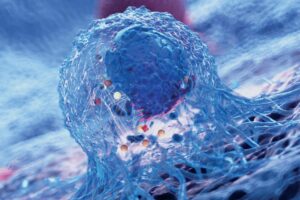What is already known
Mutations in the gene CRB1 are associated with inherited eye conditions such as retinitis pigmentosa — a disease that makes cells in the retina break down over time, causing blindness. CRB1 is known to be expressed in the retina and brain, and it is crucial to building the protective barrier around the eye. But whether CRB1 is expressed in other tissues outside of the retina and brain is unknown.
What this research adds
Working in mice, researchers have found that CRB1 contributes to regulate the integrity of the lower gastrointestinal tract. Dampening the expression of CRB1 enables bacteria to travel from the gut through the body and into the eye, leading to lesions in the retina. Giving antibiotics to mice lacking CRB1 prevented damages to their eyes.
Conclusions
The findings suggest that inherited eye diseases are caused in part by gut bacteria that travel to the retina.
More than 5 million people worldwide suffer from inherited retinal diseases such as retinitis pigmentosa — a condition that makes cells in the retina break down over time, causing blindness. Now, researchers have found that some of these diseases may be caused in part by gut bacteria that travel to the eye.
The findings, published in Cell, also indicate that antimicrobial drugs may ease the symptoms associated with retinal damage. “We found an unexpected link between the gut and the eye, which might be the cause of blindness in some patients,” says study co-author Richard Lee at University College London in the United Kingdom.
Retinitis pigmentosa and other inherited eye diseases are caused by mutations in a gene called CRB1. This gene is known to be expressed in the retina and brain, and it is crucial to building the protective barrier around the eye. But whether CRB1 is expressed in other tissues outside of the retina and brain is unknown.
Lee, Shanzhen Peng at Sun Yat-sen University in Guangzhou, China, and their colleagues set out to answer this question by studying mice that lack the gene CRB1.
Gut barrier integrity
The researchers found that CRB1 is not only crucial for maintaining the integrity of the eye’s barriers, but it also contributes to regulate the integrity of the lower gastrointestinal tract. In mouse lacking CRB1, bacteria were able to travel from the gut through the body and into the eye, leading to lesions in the retina, the researchers found.
In the retina of mice lacking CRB1, the team observed an enrichment of five bacterial species, including Anaerostipes hadrus, Bifidobacterium pseudocatenulatum and Oscillibacter valericigenes.
Giving antibiotics to mice lacking CRB1 prevented damages to their eyes. However, the antimicrobial treatment did not rebuild the damaged cell barriers in the eye.
Transforming treatment
Further experiments showed that restoring the expression of CRB1 in the gut also ameliorated the retinal damage associated with the gene.
Although the findings reveal that CRB1-associated retinal degeneration is partly dependent on bacterial translocation from the gut to the retina, more work is needed to understand whether this applies in humans, the researchers say.
“Our findings could have huge implications for transforming treatment for CRB1-associated eye diseases,” Lee says. “We hope to continue this research in clinical studies to confirm if this mechanism is indeed the cause of blindness in people, and whether treatments targeting bacteria could prevent blindness.”
The findings, he adds, may also have implications for a broader range of eye diseases beyond those associated with CRB1.











